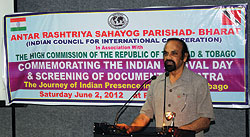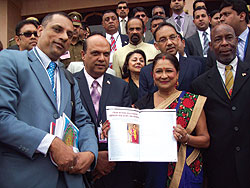|
As a person of India origin how far do you think ties have been fostered between our two nations, India and Trinidad and Tobago?
I think ties have greatly improved. I believe information flow is critical in building up ties and rapport with one another. In this sense, our website and our efforts to penetrate media at different levels have been successful. The Prime Ministerís visit to the PBD 2012 at Jaipur as chief guest gave us a chance to enhance communications between the High Commission of Trinidad and Tobago and the rest of India. I see genuine benefits come out of that visit. Now more people are aware of TnT, you donít have to name Brian Lara every time to say where you come from. In two years weíve made a big impact.
Let me add that from my observation, in the past we used to try to penetrate mainly through trade and economic ties, trade fair-type programmes. We are trying to programme at different levels and with different sections of the recipient states so that our message gets deep into the Indian society. Our whole level of operations here has gone a long way in visualizing and selectively pitching our culture, sports and other events. And it is working for us.
 |
 |
| Mr Singh addressing a gathering |
Editor Chakravarty (left) presents a copy of India Empire magazine to Trinidad and Tobago Prime Minister Kamla Persad-Bissessar at PBD 2012 |
What are the prime areas of bilateral importance at this point?
First of all trade, investment and tourism opportunities in Trinidad and Tobago are main areas of focus. A great deal of the work that I do is dedicated towards that. I do not rely greatly or too much on trade fairs and seminars. I believe in personal connections with people who have the capability, ability and the desire to invest in Trinidad and Tobago. So we have made more progress, as a result. In the past we had lots of activities but less commitment in terms of actual investors. I try and see how we can reverse the imbalance in our trade in the absence of any spare capacity to export LNG, urea, oil and gas to India. We are trying to promote our creative industries in India. As far as Indian economy goes, there are opportunities for us in the fashion industry, music, cosmetics and all other areas in the creative industry. We have lots to offer there. We have probably not paid enough attention in penetrating the Indian market with TnT garments and music in the past. The market for these items is very high and we can capitalize on that.
How far do Indian Government programmes help in strengthening bonds and ties?
The Government of India has exchange programmes through the ICCR and other agencies. Those programmes are incredible, but limited. We cannot continue to depend on Governmental exchange programmes alone. We need to commercially promote our cultural products and for that we have to tap into the private sector. We have to organize the funds that can pay artistes at commercial rates, that is how you can get top professional organizations that can adopt, promote and sell our cultural products. If we can identify a dozen such organizations, we can market our Carnival, Calypso, Limbo and other art forms. We can surely help energize some of the carnivals in India.
Your forefathers left Indian shores and youíve had historical connections. You yourself came to study in India before joining the diplomatic service. But is the young person of Indian origin in Trinidad and Tobago able to show the same degree of interest in India today as you had shown?
Thatís a very good question. Am glad you raised that. It is a subject close to my heart and an area of interest to me. When I came to India 38 years ago, I was the first in my entire family to come to India. We were up until that point closely connected to India through religion, music and films. I had a deep appetite to visit India, touch its soil and witness the source of where that inheritance came from. Young people in my country have more choices today. Iím afraid what has happened with the younger generation is that they are way too exposed to the world and have choices of cultures other than that of India. It is very difficult to sustain the interest of the younger people in the diaspora unless we provide very competitive, deliberate and organized expose of Indian culture and way of life to them.
How does Bollywood work in your country to bring you closer to India?
Iíve to say this. During the time we grew up, we were exposed to the older Hindi films that showcased more of Indian way of life. In a way we were more familiar than the younger generation of today with Ramayana, Mahabharata and Gita. Movies like Mother India and Pakeeza impacted us for years. Some of what we got to see was a nice, pure version of India. When we came we did not only see the poverty or the problems. Some do, of course. But I would say the magic of the films of yesteryears left a lasting impression on our minds. That pull is missing today. I donít think the younger generation is interested in seeing an Indian movie that gives them a rehashed westernized view of India. The youth donít want to see Michael Jackson-inspired dancing, they have America at their doorstep for that.
Are you satisfied with the way the programming is done at the PBD?
There has to be a differentiation between the young Indian in the diaspora whose ancestors left over 150 years ago, as opposed to those Indians in the wider diaspora who continue to go to the metropolitan centres of the world such as New York, London, Paris and so on. What those from the older diaspora are looking forward to may not be in sync with what the newer ones are looking at. So that difference has to be made out and should be addressed in conferences such as the PBD.
What needs immediate attention in India from a Trinidadian perspective?
The Government of India through its various agencies should pay more attention to us in the Caribbean. Although we are small, our people have been able to develop a powerful image of themselves. Our leadership in trade, oil and gas sectors, our incredible creativity in the cultural arena, our Steel Pan, our Socca, our Chutney have created impact all over the world. 43 per cent of our population is of Indian origin. We are an outstanding example of multicultural harmony. Our people of African, East Indian, European and Chinese origin blend into one nation. We do, of course, have our differences as multi-ethnic communities do. But weíve minimized the sharpness of those differences. Thatís what India needs to pick up from the Trinidad experiment, our very high levels of tolerance and harmony, the way weíve overcome barriers. TnT is a microcosm of the world.
What inspires you about India still?
In any country aside from all the beauty, song, cuisine, geography, it is the people of that country that really matter. India and its people inspire me. My ancestors came from here. To begin with I found out that this is a fascinating land where you had Tagore, Gandhi and Nehru and other great personalities. There is an incredible variety of cuisine, music, song, dance, costume, lifestyle, and an enchanting environment. I am fascinated by the people who create all of this richness. As I move around India, I immerse myself with the people and the great diversity of this country which inspires
me.
|